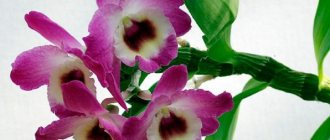Campanula is a delicate houseplant considered one of the most beautiful inhabitants of the windowsill. It is also called the “Bride and Groom” flower due to the fact that most species are colored white and blue. But hybrids have also appeared that have a completely virgin white or azure blue hue.
The shape of flowers is similar to church bells, so they have long symbolized spirituality, decency, modesty, chastity, humility and love for loved ones. Their unobtrusive but exquisite beauty has become one of the reasons for their popularity. There are several signs and superstitions associated with these sophisticated house bells.
What kind of plant
This delicate indoor plant, which many gardeners love so much, is popularly called the bride. This flower also has a completely scientific name. In the biological reference book it is called Campanula, which means “bell”.
White campanula in a pot on the windowsill
The houseplant campanula, or bride, is a small herbaceous perennial, about 15 centimeters in height. It has creeping, creeping stems on which there are long petioles with small (up to 5 cm) heart-shaped leaves. The surface of the leaves is light green with jagged edges.
The inflorescences are paniculate, the flowers are pale blue, lilac or white. The shape of the flowers is a five-petaled bell, the shape very much resembles a star. The size of the flowers is small - about 3 centimeters in diameter. In common parlance, the campanula with white flowers is called the bride, and its variety with blue flowers is called the groom. The period of abundant flowering lasts from the first days of June until the end of October.
Scientific name for “groom” and “bride”
In fact, the flower is a bell, so loved by everyone since childhood. And this is what the flower “bride” is called scientifically - it is a campanula, like, in fact, all known bells. The plant is perennial and herbaceous.
The “bride” or “groom” blooms at home almost without interruption. The “bride” will be especially delighted if you provide her with a little more comfort for life. And it’s worth it, because the “groom” and “bride” flowers are considered a talisman for the family.
Description
Hybrid with lilac flowers
Campanula is a well-known houseplant that belongs to the bellflower family. It can be found in the wild in many countries of Southern Europe.
A significant number of species of this plant have been cultivated and are now actively used as indoor plants.
- Campanula can be either annual or perennial.
- Plants are varied in shape, flower color, size, and there are hybrid double forms.
- Campanula equifolia is cultivated as an indoor crop. This plant is perennial, with thin shoots, sometimes creeping, in rare cases hanging down up to 25 cm long.
- The arrangement of the leaves is alternate; the leaf blades are attached to the stems with the help of elongated petioles.
- The leaf shape is heart-shaped or oval with small teeth. The leaves range in color from light green to dark green.
- The flowers are collected in inflorescences of several pieces; after flowering, a small fruit appears in the form of a box.
- Among indoor flower lovers, the most common hybrid is “Alba” (with white flowers) and “Maya” (with blue or purple flowers). People call them “the bride and groom.”
Hybrid "Alba"
All representatives of the bellflower family are not very demanding; they need the most basic things - watering, moderate lighting, and periodic feeding.
Flowering and dormancy
Bride and Groom flowers are white, blue or purple. To ensure more abundant and prolonged flowering, timely removal of wilted bells is necessary. In summer it will be a good idea to keep Campanula in partial shade in the fresh air. Interestingly, if you place the plant on a south-facing window in winter, it may bloom. In autumn, when daylight hours shorten, Campanula stops its growth and goes into a dormant state. In order to better prepare the flower for the seasonal rest, the elongated branches are cut off and the plant is kept cool. In spring, the “bride and groom” flowers are returned to a warm room, dried shoots are removed, and watering is gradually increased.
Types and varieties popular in indoor floriculture
Not all bred varieties take root in society. Some of them remain only in nurseries, but others are becoming very common and can be found on window sills in every city.
Equal-leaved
These include popular classic varieties - Alba (white), Maya (blue) . The length of the branches reaches 30 cm, and they hang freely from the pots. The leaves are slightly carved, with long green stalks.
Important! These varieties are the most common among gardeners. It was they who were given the popular names - bride and groom.
Campanula terry
This variety has more resistant branches, and they stretch up to a certain length and do not fall off. The leaves are slightly heart-shaped and light green. Breeders obtained the variety by crossing Carpathian and portenslag campanula.
The flowers are medium-sized, double, similar to small roses. The most popular colors are blue and white, but there are pink and pale blue. This variety is one of the most finicky, and therefore has limited popularity.
Terry mini
The length of the lashes is shortened, and they are always raised up. The leaves are small and usually dark green. The flowers are miniature, up to 1.5 cm, in the shape of small roses. Like regular terry varieties, they come in white, blue and light blue. Pink ones have also been bred, but they are difficult to buy.
Pozharsky
It has several varieties, but they all have approximately the same appearance. Large leaves are located on relatively short stems (up to 20 cm) . This is one of the few varieties that can grow both in a pot and in open ground.
The flowers look more like stars, and some of them have no resemblance to bells at all. They bloom on a long peduncle, located along its length. The color is replete with a variety of shades: from white to blue with a purple tint.
Portenschlag
Ground cover variety: the stems are short, growing up to a maximum of 10 cm. Single flowers bloom at the tops in the shape of an open bell, the petals of which are slightly curled. The leaves have long petioles, a jagged edge, and are round or heart-shaped.
Portenschlag blooms like a dome over the pot. The flowers are large (up to 2.5–3 cm), white or blue.
Carpathian (carpathic)
Can be grown in pots and open ground (resistant to frost down to –40 °C). The variety was discovered in the Carpathians and became one of the popular crops in floriculture.
The length of the branched, bristly stems reaches 40 cm. The leaves are heart-shaped, light green, fleecy, with a clear pattern of veins and a jagged edge.
The flowers are bell-shaped and vary in size, depending on the subspecies. Coloration varies from white to blue and purple.
Napoli and Atlanta
Low bushes with erect stems. The leaves are medium-sized, heart-shaped, light green.
The flowers are large, about 3 cm. The color of Napoli is blue, closer to a purple hue (it is called the groom). Atlanta, respectively, is white - this is a bride's indoor flower.
Campanula Blauranka
This plant is a low-growing variety of Campanula Pozharsky. The foliage of this plant is large, and the color of the flowers is bluish. The stems can reach about 20 centimeters in length. This flower can be grown both in the garden and at home.
Charming campanula
Campanula (“Bride and Groom”) is a perennial herbaceous bell native to the Mediterranean. In nature, there are approximately 300 species of these flowers. The height of the plant is approximately 20 cm, the stems are creeping, creeping, heart-shaped leaves are located on long petioles. Their length is 5 cm. The surface of the leaves is light green, the edges are jagged. Campanula flowers are white or light blue, five-petaled, bell-shaped, resembling a star, up to 4 cm in diameter. They bloom at the tips of the shoots and form a lush ball of bells.
The “bride and groom” garden flower blooms throughout the warm period of the year almost continuously and so abundantly that sometimes the foliage is not even visible behind the cap of “stars”. Flowering begins in spring and continues until late autumn. Fruit type: capsule.
"Groom", "bride" and "lover"
Campanulas are equifolia primarily in color. This:
"Bride"
It is not difficult to guess that “Bride” is an indoor plant with white flowers. It looks gentle and cute.
"Groom"
“Groom” has a purple or bluish color. Blends perfectly with her snow-white friend.
"Lover" (bicolor)
A love triangle is incomplete without introducing the two-colored “lover.” The center of the flower is white, the edges are purple.
Within these groups of campanulas there is a division into varieties and species according to doubleness, shape of petals and type of shoots: ampelous (hanging) or semi-ampeloid). For example, a white “bell” can be either simple or double.
Purchasing a plant
Before you begin implementing our recommendations, you need to purchase the plant itself. You can buy it in stores by browsing the flower departments. I must say, he is not a very frequent visitor to such places. But if you are lucky, you will become the happy owner (or possessor) of this green pet.
The second purchasing option is to buy from grandmothers. Ask around, maybe someone will agree to sell you a young plant.
Checking roots
If the root system looks pretty good externally, do not rush to replant the beauty. Firstly, she needs to undergo acclimatization in your apartment or house. This is a stressful situation, and if you add to it a replanting with freeing the roots from the soil, it will not be difficult to destroy the flower.
Dilute the drug “Fitosporin” in water. The color of the concentrate should resemble strong black tea. From this concentrate, prepare a solution for irrigation: 15 drops per liter of irrigation water. Spray the plant with Fitosporin. This needs to be done as soon as you arrive home and look at the roots. “Fitosporin” will destroy fungi and spores that contribute to the spread of root and other rot.
Pest treatment
Now let's examine the green mass of the plant. Often unexpected guests “come” to us from the store - all kinds of pests that attack leaves and flowers. If light spots are noticeable or something else bothers you about the general appearance of the plant, treatment is needed. You can use “Fitoverm” or “Intavir”. Dilute the drug according to the instructions and treat the above-ground part of the plant. By the way, you can also water the ground if the soil allows it.
Trimming shrunken parts
We can say that your indoor flower “bride” has been saved. How to care next? Remove any blooms on the plant. Carefully cut off damaged leaves and broken stems with sharp scissors. Now your “bride” is almost ready for the next step of post-purchase processing.
Campanula transplant
A newly purchased campanula should not be disturbed for several days, during which time it must adapt to new conditions. After this, it must be transplanted. To do this, use a wide pot, at the bottom of which a good drainage layer is made. A suitable soil mixture must be loose, its composition: peat, humus, coarse sand and leaf soil (1: 1: 1: 1).
Next, the bush is replanted in the spring at the very beginning of active growth. But experienced flower growers advise not to replant the old bush, but to grow a new flower from cuttings in the spring.
Plant diseases and pests
The most common problem with Campanula is the fungal disease gray mold. As a rule, the cause of its occurrence is excessive watering and too high air humidity. When the roots begin to rot, the plant becomes very lethargic and the soil acquires an unpleasant odor. What needs to be done? First of all, remove the affected part and replant the flower. In addition, watering should be reduced.
Campanula pests that need to be controlled with insecticides are:
So, “bride and groom” is a delicate and unpretentious flower from the bellflower family. It is enough to provide it with suitable conditions and care, and the plant will give a lush scattering of beautiful flowers and turn the house into a real fairy-tale garden.
Caring for Campanula at home
Light and warmth
Bride and groom flowers grow in indirect sunlight. But despite this, windows to the north are unlikely to suit him. Due to lack of light, the shoots will stretch out and flowering will stop. The plant will lose its beauty.
Optimal lighting conditions are created near windows facing west and east. Campanula will bloom wonderfully next to them in hanging flower pots.
If the window faces south, direct sun will burn the tender leaves. In addition, the “bride” flowers will suffer from drying out soil. If there are no other windows, the plant must be shaded to protect it from the bright sun.
The heat is harmful for the campanula, while it loves open air very much. In summer, the flower will live perfectly on the loggia or in the country house. During the warm period, the favorable temperature should be about twenty degrees. In winter, the plant needs to rest and gain strength for the next flowering. Therefore, he is provided with a temperature of no more than fourteen degrees Celsius.
Soil preparation
Universal soil for decorative flowering plants can be purchased at a flower shop. You can also cook it yourself. To do this, you will need coarse river sand, turf, dry humus, compost and leaf soil. All components are taken in equal parts. After planting, it is very important to periodically loosen the soil in the flower pot, since the plant needs oxygen, which promotes the active development and flowering of the campanula.
Additional Information. The soil for growing campanula should be light and easy to loosen. Regular black soil is too heavy for such a delicate flower.
Choosing a pot
With the arrival of spring, the plant must be transplanted into a new pot, since over the year the soil in the old pot has become very depleted and has lost its nutritional qualities. In early March, the indoor groom or bride flower must be transplanted into new soil rich in useful components.
Flower pot with bride
An overgrown plant needs a new spacious pot so that the roots do not suffer due to cramped space. After transplanting or planting, the plant goes through an adaptation period, so it should be removed away from bright sunlight and not fertilized for one week.
Watering
Campanula is distinguished by its moisture-loving nature; therefore, watering should be abundant and systematic, especially on hot days. During the dormant period, watering is carried out very rarely, approximately 1 or 2 times every 30 days, but do not allow the earthen ball in the pot to dry out. Water the flower with well-settled water, which should be at room temperature or a little warmer.
Reproduction
If the plant has grown enough and does not fit into the volume of the container, it must be divided into several parts. Carefully remove the bush from the pot with a lump of earth. Using a sharp knife, the rhizome is cut into pieces.
Don’t forget to treat the cut areas with crushed wood charcoal. Plant the resulting parts in new containers of smaller volume. It is not recommended to immerse plants deep into the soil. Immediately after transplanting, provide the plant with plenty of water and shade.
Propagation by cuttings
Propagation by cuttings is a very simple and common method. The lower part of the shoots is taken for cuttings. All activities begin in spring. The plant wakes up and begins to grow. When young shoots reach up to 20 cm in height, they are cut off and placed in a glass or jar of water. You can immediately plant it in the ground. When planting in the ground, the cuttings are watered with a solution of phytosporin and placed in a small greenhouse. The optimal temperature for growing cuttings is 12-13 °C.
If the cuttings were planted in the summer, then in the fall they rest, and in January or February they will begin to bloom.
Diseases and harmful insects
At home, plants are much less susceptible to diseases and pests. However, they are not 100% protected. If not properly cared for, a number of problems can arise.
Gray rot
With constant waterlogging of the soil, when there is no drainage in the flower pot, the water stagnates, which in turn leads to acidification of the soil.
Gray rot thrives in damp soil. When affected by gray rot, plants wither and the root system begins to rot.
An unpleasant odor appears in the room where the flower affected by gray rot is located. Sometimes, when the rotting goes very far, the flower can no longer be saved.
In any case, first of all, you need to cut off the rotten twigs and leaves and throw away the old soil. Transplant the flower into new light soil, reduce watering.
Fusarium
If temperature conditions are not observed, as well as in the absence of light, the viability of the plant decreases.
Sometimes fusarium can be observed on the “bride and groom” flower; it is accompanied by yellowing of the tips of the leaf blades. In severe forms, the leaves die and the shoots wither from the root.
Heart rot
If you find brown heart-shaped spots with a gray coating on the leaves, then it is likely that the plant has developed brown heart-shaped rot.
This disease is caused by pathogenic microscopic fungi. To combat them, fungicides are used, while watering is reduced and the plants are regularly ventilated.
Spider mites, aphids, scale insects
If the plant is in a dry room, aphids or scale insects may appear.
At the first symptoms of these diseases, treat the plants with insecticide preparations. A proven folk remedy against aphids and scale insects is a soap solution. Spider mites are the scourge of many indoor plants. Use broad-spectrum insecticides to combat it.
An effective drug against aphids
Most often, the companula is affected by aphids
Most often, companula is affected by aphids. Aphids multiply very quickly, so control should begin when they first appear. It is better to use systemic preparations that not only destroy the pest during treatment, but also continue to act for some time in the plants themselves.
There is a drug "Biotlin" designed to protect against sucking pests.
The treatment solution is prepared at the rate of 0.5 ml of the drug per 1 liter of water. Penetrating into the plant within a few hours, the drug will protect it for at least two weeks.
Choosing a location and lighting
The “bride and groom” flower prefers bright but diffused light. The best place for it is an east or west window. If the plant is placed on the south side, it will be necessary to create shading to get rid of exposure to direct sunlight. On a northern window, the flower will most likely not have enough light, which can lead to elongation of the shoots and an increase in the spaces between the leaves, which will worsen the appearance of the campanula. In summer, the flower feels great at an air temperature of 20-22 °C, in winter - from 12 to 15 °C.
In the spring and summer, when the “bride and groom” flowers are actively growing and blooming, they need abundant watering and constant soil moisture. However, this should also be done in moderation. Water should not stagnate in pots or trays. In autumn, watering the plants should be gradually reduced so that the flowers can prepare to rest. In winter, when the “bride and groom” are kept cool, they need to be watered very rarely (once or twice a month). The plant is completely unpretentious to humidity. However, in the heat and when located next to a battery in winter, it will not be superfluous to regularly spray the leaves with water at room temperature.
Indoor flower Bride and Groom: folk signs and superstitions, the meaning of the flower
House bells are a symbol of a happy family life . It is popularly believed that campanula fills space only with positive energy if it is properly cared for. Moreover, she is completely unpretentious. Most often, two types of plants, white and blue, are bought for the house so that there is a pair.
Bells are able to take away negativity from the owner, hostess and other residents of the apartment in stressful situations. They say that if a flower suddenly dried up, it took away the damage, the evil eye, from one of the inhabitants of the house. In this case, the plant should be thanked and buried in the ground outside.
In addition, these flowers improve the overall mood and give a boost of energy to all residents of the apartment.
Superstitions, signs - the influence of the campanula flower on people
Flower Bride and Groom: can you keep it at home?
There are signs that some flowers cannot be kept in the house. They bring negativity into the house, as a result, those living in the house begin to quarrel, get sick, and, due to the presence of certain types of plants, even die. This flower is not one of those.
If you promise this plant good care, then it will only delight you with its beauty and positivity. So, if you decide to have such a miracle, then take it with confidence and it’s better to buy a couple of different colors at once: white, purple (blue).
What kind of energy does campanula carry?
Benefit
It's no secret that the ringing of church bells scares away evil spirits. This plant has the same effect.
A campanula standing in a tabletop vase will be a good talisman against negative energy seeking to enter the house. All dark entities and unkind people will not fall into it.
Blue bells planted in a garden or flower bed will bring well-being and prosperity to the site, the house and its inhabitants. That is why they are often used in cultural plantings.
How to grow a flower bride and groom: video
Sources
- https://pocvetam.ru/komnatnye-rasteniya/kaktusy/cvetok-nevesta-komnatnyj.html
- https://flowerf.ru/landshaftnyj-dizajn/tsvetok-nevesta-komnatnyj-kak-uhazhivat.html
- https://krrot.net/cvetok-genix-i-nevesta/
- https://ProZvety.ru/katalog-rastenij/krasivotsvetushhie/komnatnyj-cvetok-nevesta
- https://rastenievod.com/kampanula-zhenih-i-nevesta.html
- https://kopilpremudrosti.ru/komnatnyj-cvetok-zhenih-i-nevesta.html
- https://41svadba.ru/vse-stati/tsvetok-zhenih-i-nevesta-nauchnoe-nazvanie-uhod-v-domashnih-usloviyah-razmnozhenie-peresadka-komnatnyj-tsvetok-zhenih-i-nevesta-primety-v- narode-kak-vyglyadet-nezabyvaemo-na-vashih-svadebnyh-fotogra.html
- https://sadovnikam.ru/474869a-komnatnyiy-tsvetok-nevesta-kak-uhajivat-posle-pokupki
- https://sadovnikam.ru/415808a-tsvetok-jenih-i-nevesta-opisanie-uhod-foto
- https://felisov.ru/komnatnye-rasteniya/cvety-zhenih-i-nevesta.html
- https://heaclub.ru/cvetok-zhenih-i-nevesta-nauchnoe-nazvanie-uhod-v-domashnih-usloviyah-razmnozhenie-peresadka-komnatnyj-cvetok-zhenih-i-nevesta-primety-v-narode
- https://TheKomod.ru/dekor/kak-posadit-tsvetok-nevesta-i-zhenih.html











